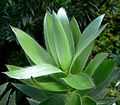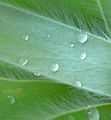Leucadendron argenteum
| Leucadendron argenteum | |
|---|---|
 | |
| A young Silvertree growing in Kirstenbosch Botanical Gardens in Cape Town. | |
| Conservation status | |
| Scientific classification | |
| Kingdom: | Plantae |
| (unranked): | Angiosperms |
| (unranked): | Eudicots |
| Order: | Proteales |
| Family: | Proteaceae |
| Genus: | Leucadendron |
| Species: | L. argenteum |
| Binomial name | |
| Leucadendron argenteum (L.) R.Br. | |
 | |
| Map of the current surviving population of Silvertrees within the city of Cape Town. | |
Leucadendron argenteum (Silver tree, Silver leaf tree, Afrikaans: Witteboom, or Silwerboom) is an endangered species in the family Proteaceae, endemic to a small area of the Cape Peninsula, in and around the city of Cape Town, South Africa. The Silver Tree is a protected tree in South Africa.[1]
Appearance

The Silvertree is a striking evergreen tree, growing 5–7 m tall (sometimes up to 16 m). It is erect and well-proportioned with a thick, straight trunk and grey bark. The soft, silky leaves are shiny silver, lanceolate, 8–15 cm long and 2 cm broad, with their distinct silvery sheen produced by dense velvety hairs. The wind-pollinated flowers are produced in dense globose inflorescences 4–5 cm diameter, and give off a pleasant scent. Like all Leucadendrons, this tree is dioecious, with separate male and female plants. The fruit is a heavy woody cone, containing numerous seeds; each seed is a small nut with a silky-haired helicopter-like parachute, enabling it to disperse by wind.
Distribution
This enormous silver Protea is naturally confined to a tiny area in and around the city of Cape Town. Its main population grows on the slopes of Table Mountain, notably the Lion's Head area, above Rhodes Memorial and the mountain slopes above Kirstenbosch National Botanical Garden.
In addition there are two tiny outlying populations nearby, in Stellenbosch and Paarl (It has not yet been established for certain whether these are natural outliers, or were planted here in early Cape history).
Historically, the Silvertree was more widespread on Table Mountain, covering much of its slopes in shimmering silver forests. However, early demand for timber led to much of these forests being felled and now the Silvertree is a rare and endangered species.[2]
Situation of the Silvertrees on Table Mountain

Table Mountain might be the only place where these trees grow naturally in the wild (there is controversy about whether the populations in Stellenbosch and Paarl were introduced from Table Mountain).
In the face of urban development, inappropriate fire management, and invasive alien trees such as pines and gums, silvertrees have been driven from about 74% of their natural range.[3]
Within the remaining habitat, an estimated 40 to 50 percent of the entire world's native population of these trees was destroyed between 26 January and 27 January in the 2006 Table Mountain fire . However, as recruitment of seedlings only occurs naturally after fire this is a necessary stage in the life-cycle of this Fynbos species. Recruitment after the fire has been good, and the population has recovered totally. It will however take another few years before this population produces seeds, during which time it would be vulnerable to extinction by further fires.
Conservation
A major deterrent to propagation of the silver leaf tree is its short life span. Most individuals don't live more than 20 years. But that is not a problem for conservation as fires rejuvenate populations on average every 15–20 years by killing the surviving adults and triggering release of the canopy seed bank (in the cones), and germination of the soil seed bank. Juveniles take 5–7 years to flower and set seed, whereafter the populations are ready to burn again.
Heraldry
[S]tylized twigs of the silver tree [sic] appear in the arms of the South Peninsula Municipality of South Africa.
| Wikimedia Commons has media related to Leucadendron argenteum. |
Pictures
-
Silvertrees were nearly driven to extinction when their only natural habitat was cleared for commercial pine plantations.
-
Leucadendron argenteum grows only in and around Cape Town, particularly on Table Mountain.
-
A large Silvertree near Rhodes Memorial.
-
A young stand of Silvertrees on Devil's Peak, Table Mountain.
-
A Silvertree forest on the lower slopes of Devil's Peak.
-
Since the partial removal of the invasive pine plantations, the Silvertree forests have gradually returned.
-
The leaves of Leucadendron argenteum are soft and silky.
-

New growth detail.
-

The silver colour of the leaves comes from their soft velvety hair.
-
-

After flowering, the female trees produce heavy cones. These eventually open to release the small, round nuts.
-

Specimen of a cone, seeds, leaf and juvenile plant.
See also
- List of Southern African indigenous trees
- Peninsula Granite Fynbos
- Silwerboomkloof
- Rhodes Memorial
- Newlands Forest
References
- Hilton-Taylor, C. et al. (1998). Leucadendron argenteum. 2006. IUCN Red List of Threatened Species. IUCN 2006. www.iucnredlist.org. Retrieved on 11 May 2006. Listed as Vulnerable (VU D2 v2.3)
- ↑ "Protected Trees". Department of Water Affairs and Forestry, Republic of South Africa. Retrieved 13 June 2013.
- ↑ http://www.proteaatlas.org.za/cpldarge.htm
- ↑ http://redlist.sanbi.org/species.php?species=794-8
External links
- Leucadendron argenteum Plantzafrica.com
- Leucadendron argenteum at the University of Pretoria website
- Leucadendron argenteum in the Protea Atlas








